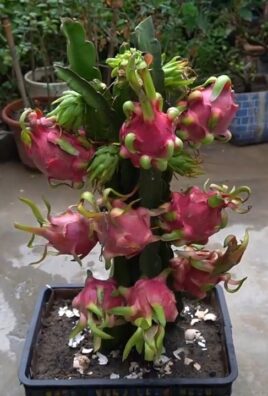Growing sunflowers in containers might seem like a challenge, but trust me, it’s totally achievable, even if you don’t have a sprawling backyard! Have you ever dreamed of waking up to the cheerful faces of these sunny giants, but thought your limited space was a barrier? Well, dream no more! This DIY guide is packed with simple tricks and hacks to bring the joy of sunflowers right to your patio, balcony, or even a sunny windowsill.
Sunflowers have a rich history, deeply intertwined with Native American cultures, where they were not only a food source but also held spiritual significance. They were revered for their beauty and resilience, qualities we can all appreciate. Today, sunflowers symbolize adoration, loyalty, and longevity – all wonderful sentiments to bring into your home.
But why should you bother growing sunflowers in containers? Beyond their aesthetic appeal, sunflowers attract pollinators like bees, which are vital for a healthy ecosystem. Plus, nurturing a plant from seed to bloom is incredibly rewarding. In this article, I’ll share my tried-and-true methods for selecting the right container, choosing the perfect sunflower variety, and providing the care these beauties need to thrive. Let’s get our hands dirty and create a little sunshine together!

Growing Sunflowers in a Pot: A Comprehensive DIY Guide
Hello dear garden friends! I love sunflowers. Their radiant faces simply bring joy to any garden. And the best part? You don’t need a huge garden to enjoy these beauties! Today, I’m going to show you how you can easily grow sunflowers in pots. It’s easier than you think and a lot of fun!
What You Need: The Right Equipment
Before we get started, here is a list of everything you’ll need. Don’t worry, you probably have most of these things at home already!
- Sunflower seeds: It’s best to choose varieties that are suitable for growing in a pot. Dwarf sunflowers or varieties like ‘Teddy Bear’ or ‘Elf’ are ideal. They stay smaller and don’t get too heavy for the pot as quickly.
- Large pots: The bigger, the better! Sunflowers have deep roots. A pot with at least a 30 cm (12-inch) diameter and depth is a good start. For larger varieties, I recommend even bigger pots (45 cm / 18 inches or more).
- High-quality potting soil: Use a well-draining potting soil. I often mix in some compost to make the soil even more nutrient-rich.
- Drainage material: Clay shards, pebbles, or expanded clay at the bottom of the pot ensure good drainage and prevent waterlogging.
- Watering can or hose: For regular watering.
- Fertilizer: A slow-release fertilizer or a liquid fertilizer for flowering plants.
- Stakes (optional): For larger varieties, to support the stems in strong winds.
- Pruning shears: To remove wilted leaves or flowers.
- A sunny spot: Sunflowers love the sun! Find a place that gets at least 6 hours of sun per day.
Preparation: The Foundation for Success
Good preparation is the key to healthy and happy sunflowers.
- Prepare the pot: Start by cleaning the pot thoroughly. Then, place a layer of drainage material at the bottom. This prevents the roots from sitting in water and rotting.
- Fill with soil: Fill the pot with potting soil. Leave about 5 cm (2 inches) of space to the rim. The soil should be loose and airy.
- Add fertilizer: If you are using a slow-release fertilizer, mix it into the soil now. Pay attention to the dosage instructions on the packaging.
The Sowing: The Start of Life
Now for the exciting part: sowing the seeds!
- Place the seeds: Make small holes in the soil (about 2-3 cm or 1 inch deep). Place 2-3 seeds in each pot. This increases the likelihood that at least one plant will germinate.
- Cover with soil: Gently cover the seeds with soil and press down lightly.
- Water: Water the soil carefully so that it is well-moistened. Be careful not to wash the seeds away.
- Place in a warm and sunny spot: Put the pot in a warm and sunny location. The ideal germination temperature is between 20 and 25 degrees Celsius (68-77°F).
Care: Ensuring Your Sunflowers Flourish
Proper care is crucial for your sunflowers to grow big and strong.
- Watering: Water regularly, especially on hot days. The soil should always be slightly moist, but not wet. Avoid waterlogging! It’s best to water in the morning or evening when the sun is not as strong.
- Fertilizing: Start fertilizing about 2-3 weeks after the seeds have sprouted. Use a liquid fertilizer for flowering plants and follow the dosage instructions on the package. Fertilize every 2-3 weeks.
- Sunlight: Sunflowers need a lot of sun! Rotate the pot regularly so that all sides of the plant get enough light.
- Supporting: As your sunflowers grow taller, you may need to support them, especially in strong winds. Use plant stakes and gently tie the stems to them.
- Pests and Diseases: Keep an eye out for pests like aphids or slugs. If necessary, you can use organic pesticides. Fungal diseases can also occur, especially in damp weather. Ensure good air circulation and remove any affected leaves.
- Deadheading: Regularly remove wilted flowers to encourage the formation of new blooms.
Special Tips for Growing in a Pot
Growing in a pot is slightly different from growing in the ground. Here are a few extra tips that will help you:
- Pot size: Choose the right pot. As mentioned, sunflowers need space for their roots. A pot that is too small can hinder growth.
- Soil: Use high-quality potting soil. Potting soil dries out faster than garden soil. Make sure the soil is well-draining but still retains moisture.
- Watering: Water regularly, but avoid waterlogging. The soil in a pot dries out more quickly than in the ground.
- Fertilizing: Fertilize regularly, as the nutrients in a pot are used up more quickly.
- Location: Choose a sunny spot. Sunflowers in pots can be more easily moved to a different location as the sun moves.
- Overwintering: Most sunflower varieties are annuals and do not survive the winter. However, you can collect the seeds and sow them again the following spring.
Common Problems and Solutions
Problems can also arise when growing sunflowers in pots. Here are a few common issues and how you can solve them:
- Yellow leaves: Yellow leaves can have various causes, such as too much or too little water, nutrient deficiency, or pests. Check the soil and adjust your watering. Fertilize if necessary. Examine the leaves for pests.
- Wilted leaves: Wilted leaves usually indicate a lack of water. Water the plant thoroughly.
- Small flowers: Small flowers can indicate a nutrient deficiency or not enough sunlight. Fertilize the plant and move it to a sunnier location.
- Plants falling over: Plants that fall over can be a sign of a pot that is too small, a lack of support, or too much wind. Use a larger pot, support the plant with stakes, and move it to a more sheltered spot.
- Pests: Aphids, slugs, and other pests can infest sunflowers. Use organic pesticides or remove the pests by hand.
The Harvest: The Reward for Your Efforts
When your sunflowers have finished blooming, you can harvest the seeds. Let the flower heads dry completely before you remove the seeds. You can use the seeds as bird feed or sow them again next spring.
I hope this guide has helped and inspired you to grow your own sunflowers in a pot. It is a truly rewarding project that will reward you with beautiful flowers and a lot of joy. Happy gardening

Conclusion
So, there you have it! Growing sunflowers in containers isn’t just a whimsical dream; it’s a readily achievable reality that can bring a burst of sunshine and joy to even the smallest of spaces. We’ve walked through the steps, from selecting the right variety and container size to nurturing your seedlings and providing the essential care they need to thrive.
But why is this DIY trick a must-try? Beyond the sheer aesthetic pleasure of watching these majestic blooms unfurl, growing sunflowers in containers offers a unique opportunity to connect with nature, even in the heart of a bustling city. It’s a therapeutic activity, a learning experience, and a conversation starter all rolled into one. Plus, imagine the satisfaction of harvesting your own sunflower seeds for a healthy snack or to share with feathered friends!
And the possibilities don’t end there. Feel free to experiment with different sunflower varieties. Dwarf sunflowers, like ‘Teddy Bear’ or ‘Elf,’ are particularly well-suited for containers, offering a profusion of smaller, more manageable blooms. You could also try branching varieties, which produce multiple flower heads for an extended display.
Consider companion planting in your containers as well. Marigolds, with their vibrant colors and pest-repelling properties, make excellent companions for sunflowers. Nasturtiums are another great choice, adding a peppery flavor to salads and attracting beneficial insects.
Don’t be afraid to get creative with your container choices, too. While terracotta pots are classic and charming, you can also use repurposed buckets, galvanized tubs, or even fabric grow bags. Just ensure that your chosen container has adequate drainage to prevent waterlogging.
Growing sunflowers in containers is a rewarding experience that anyone can enjoy. It’s a chance to bring a little bit of the countryside to your balcony, patio, or windowsill. It’s a project that’s both educational and aesthetically pleasing.
We encourage you to give this DIY trick a try. Start small, experiment with different varieties, and don’t be afraid to make mistakes. Gardening is a journey of learning and discovery, and every sunflower you grow will teach you something new.
Most importantly, we want to hear about your experiences! Share your photos, tips, and stories with us in the comments below. What varieties did you choose? What challenges did you face? What successes did you celebrate? Your insights will help other aspiring sunflower growers and inspire them to embark on their own container gardening adventures. Let’s create a community of sunflower enthusiasts and spread the joy of these magnificent blooms far and wide!
Frequently Asked Questions (FAQ)
What is the best time to start growing sunflowers in containers?
The ideal time to start growing sunflowers in containers depends on your local climate. Generally, you should sow sunflower seeds directly into your containers after the last frost has passed and the soil has warmed up to at least 60°F (15°C). In warmer climates, you can start earlier, while in colder climates, you may need to wait a few weeks longer. You can also start seeds indoors 2-3 weeks before the last expected frost and then transplant them into containers once the weather warms up. This gives them a head start and can be particularly helpful in regions with short growing seasons.
What size container do I need for sunflowers?
The size of the container depends on the variety of sunflower you’re growing. Dwarf varieties, which typically grow to be 1-3 feet tall, can thrive in containers that are at least 12 inches in diameter and 12 inches deep. Taller varieties, which can reach heights of 6-12 feet, will require larger containers, ideally at least 18-24 inches in diameter and 18-24 inches deep. The larger the container, the more room the roots will have to grow, and the more stable the plant will be, especially in windy conditions. Ensure the container has adequate drainage holes to prevent waterlogging.
What type of soil is best for sunflowers in containers?
Sunflowers thrive in well-draining, fertile soil. A good potting mix specifically formulated for containers is ideal. You can also create your own mix by combining equal parts of potting soil, compost, and perlite or vermiculite. Compost provides essential nutrients, while perlite or vermiculite improves drainage and aeration. Avoid using garden soil in containers, as it can become compacted and doesn’t drain well.
How often should I water sunflowers in containers?
Sunflowers in containers need regular watering, especially during hot, dry weather. Water deeply whenever the top inch of soil feels dry to the touch. Avoid overwatering, as this can lead to root rot. The frequency of watering will depend on the size of the container, the weather conditions, and the type of soil you’re using. Check the soil moisture regularly and adjust your watering schedule accordingly. During peak growing season, you may need to water daily.
Do sunflowers in containers need fertilizer?
Yes, sunflowers in containers benefit from regular fertilization. Use a balanced, water-soluble fertilizer, such as a 10-10-10 or 20-20-20 formula, diluted to half strength. Fertilize every 2-4 weeks during the growing season, starting when the plants are a few inches tall. Avoid over-fertilizing, as this can lead to leggy growth and fewer blooms. You can also amend the soil with slow-release fertilizer granules at planting time for a continuous supply of nutrients.
How much sunlight do sunflowers need?
Sunflowers need at least 6-8 hours of direct sunlight per day to thrive. Choose a location for your containers that receives plenty of sunlight throughout the day. If you’re growing sunflowers indoors, place them near a sunny window or use grow lights to supplement natural light. Insufficient sunlight can result in weak, spindly plants with fewer flowers.
How do I protect sunflowers in containers from pests and diseases?
Sunflowers can be susceptible to pests such as aphids, spider mites, and sunflower beetles. Regularly inspect your plants for signs of infestation and take action promptly. You can control aphids and spider mites with insecticidal soap or neem oil. Handpick sunflower beetles or use an appropriate insecticide if necessary. To prevent fungal diseases, ensure good air circulation around your plants and avoid overwatering. Remove any diseased leaves or stems promptly.
Can I grow sunflowers in containers indoors?
Yes, you can grow sunflowers in containers indoors, but it requires providing them with adequate light and care. Choose dwarf varieties that are well-suited for indoor growing. Place the containers near a sunny window that receives at least 6-8 hours of direct sunlight per day, or supplement with grow lights. Ensure good air circulation and water regularly, allowing the soil to dry slightly between waterings. Fertilize every 2-4 weeks with a balanced, water-soluble fertilizer.
How do I harvest sunflower seeds from containers?
To harvest sunflower seeds, wait until the back of the flower head turns brown and the petals begin to dry and fall off. Cut the flower head off the stem, leaving a few inches of stem attached. Hang the flower head upside down in a dry, well-ventilated place for a few weeks to allow the seeds to dry completely. Once the seeds are dry, you can easily remove them by rubbing the flower head with your hands or a brush. Store the seeds in an airtight container in a cool, dry place.
What are some good companion plants for sunflowers in containers?
Good companion plants for sunflowers in containers include marigolds, nasturtiums, zinnias, and herbs like basil and oregano. Marigolds repel pests such as nematodes and whiteflies, while nasturtiums attract beneficial insects like ladybugs and hoverflies. Zinnias attract pollinators, and herbs can help deter pests and add fragrance to your container garden. Avoid planting sunflowers near plants that compete for nutrients or sunlight.





Leave a Comment